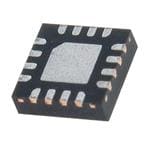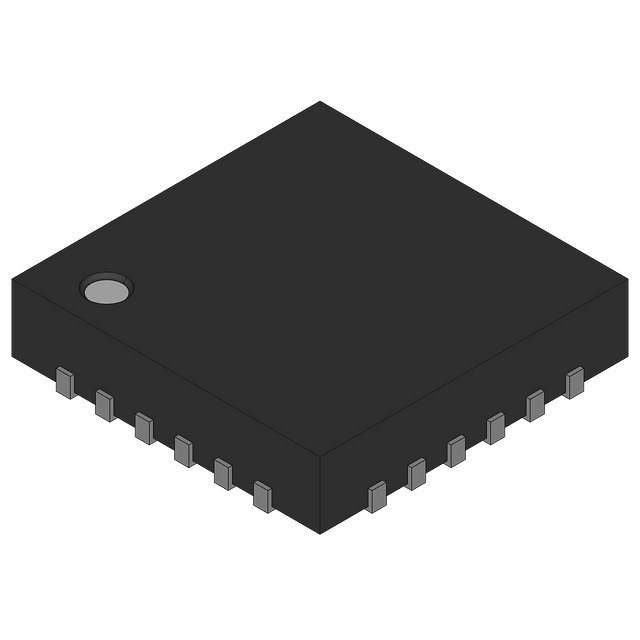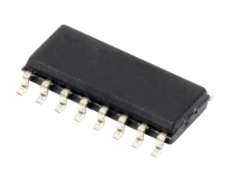EV-ADF5902SD1Z
Analog Devices Inc.The ADF5902 is a 24 GHz transmitter (Tx) monolithic microwaveintegrated circuit (MMIC) with an on-chip, 24 GHz voltagecontrolled oscillator (VCO). The VCO features a fractional-Nfrequency synthesizer with waveform generation capability withprogrammable grid array (PGA) and dual transmitter channelsfor radar systems. The on-chip, 24 GHz VCO generates the24 GHz signal for the two transmitter channels and the localoscillator (LO) output. Each transmitter channel contains apower control circuit. There is also an on-chip temperaturesensor.Control of all the on-chip registers is through a simple, 4-wireserial peripheral interface (SPI).The ADF5902 comes in a compact, 32-lead, 5 mm ? 5 mmLFCSP package. Applications Automotive radars Industrial radars Microwave radar sensors
AD8280-EVALZ
Analog Devices Inc.The AD8280 is a hardware-only safety monitor for lithium ionbattery stacks. The device has inputs to monitor six battery cellsand two temperature sensors (either NTC or PTC thermistors).The device is designed to be daisy-chained with additional AD8280devices to monitor a stack of significantly more than six cellswithout the need for numerous isolators. The output can beconfigured for an independent or shared alarm state.The AD8280 functions independently from a primarymonitor and contains a reference and LDO, both of which arepowered completely from the battery cell stack. The reference, inconjunction with external resistor dividers, establishes trip pointsfor the overvoltages and undervoltages. Each cell channel containsprogrammable deglitching circuitry to prevent alarms fromtransient input levels.The AD8280 also has two digital pins that can select variouscombinations of inputs in the case where fewer than six cells areto be monitored. Most important, it has a self-test feature, makingit suitable for high reliability applications, such as automotivehybrid electric vehicles or higher voltage industrial usage, such asuninterruptible power supplies. The AD8280 can function over atemperature range of ?40?C to +105?C. Applications Lithium ion battery backup monitor and threshold detection Electric and hybrid electric vehicle Industrial vehicle Uninterruptible power supply Wind and solar
DC1412A
Analog Devices Inc.The LT3758/LT3758A are wide input range, current mode, DC/DC controllers which are capable of generating either positive or negative output voltages. They can be configured as either a boost, flyback, SEPIC or inverting converter. The LT3758/LT3758A drive a low side external N-channel power MOSFET from an internal regulated 7.2V supply. The fixed frequency, current-mode architecture results in stable operation over a wide range of supply and output voltages.The operating frequency of LT3758/LT3758A can be set with an external resistor over a 100kHz to 1MHz range, and can be synchronized to an external clock using the SYNC pin. A minimum operating supply voltage of 5.5V, and a low shutdown quiescent current of less than 1?A, make the LT3758/LT3758A ideally suited for batterypowered systems.The LT3758/LT3758A feature soft-start and frequency foldback functions to limit inductor current during start-up and output short-circuit. The LT3758A has improved load transient performance compared to the LT3758.APPLICATIONS Automotive Telecom Industrial
ADRF6821-EVALZ
Analog Devices Inc.The ADRF6821 is a highly integrated, dual radio frequency (RF) input, zero intermediate frequency (IF)/low IF RFIC receiverwith a quadrature demodulator, digital step attenuator (DSA),IF linear amplifiers, an integrated, fractional-N phase-locked loop (PLL), and a low phase noise, multicore, voltage controlled oscillator (VCO). The RFIC is ideally suited for communication digital predistortion (DPD) systems.The high isolation 2:1 RF switch and on-chip wideband RFbalun enable the ADRF6821 to support two single-ended, 50 ? terminated RF inputs. A programmable attenuator ensures anoptimal differential RF input level to the high linearity demodulatorcore. The integrated attenuator offers an attenuation range of 15 dB with a step size of 1 dB. High linearity IF amplifiers follow the demodulator and provide an interface to the next componentin the chain, typically an analog-to-digital converter (ADC).The ADRF6821 offers two alternatives for generating thedifferential local oscillator (LO) input signal: internally viathe on-chip fractional-N synthesizer with low phase noiseVCOs or externally via a low phase noise LO signal. Theintegrated synthesizer enables continuous LO coverage from 450 MHz to 2800 MHz. The PLL reference input supports awide frequency range and includes integrated reference dividers before the phase frequency detector (PFD).When selected, the output of the internal fractional-N synthesizeris applied to a divide by 2, quadrature phase splitter. From theexternal LO path, a 2? LO signal can be used with the divide by 2,quadrature phase splitter to generate the quadrature LO inputs to the mixers.The ADRF6821 is fabricated using an advanced silicon germanium(SiGe), bipolar complementary metal oxide semiconductor(BiCMOS) process. It is available in a 56-lead, RoHS compliant,8 mm ? 8 mm LFCSP package with an exposed pad. Performanceis specified over the ?40?C to +105?C case temperature range.Applications Cellular W-CDMA/GSM/LTE DPD receivers? Microwave, point to point radios
EVAL-ADV7282AEBZ
Analog Devices Inc.The ADV7282A has the same pinout as and is software compatible with the ADV7282. The mobile industry processor interface (MIPI?) model of the ADV7282A (ADV7282A-M) has the same pinout as and is software compatible with the ADV7282-M.All features, functionality, and specifications are shared by the ADV7282A and the ADV7282A-M, unless otherwise noted.The ADV7282A is a versatile one-chip, multiformat video decoder that automatically detects standard analog baseband video signals and converts them into YCrCb 4:2:2 component video data streams.The analog input of the ADV7282A features an input mux (4-channel on ADV7282A, 6-channel on ADV7282A-M), a single 10-bit analog-to-digital converter (ADC) and an on-chip differential to single-ended converter to accommodate the direct connection of differential, pseudo differential, or single-ended CVBS without the need for external amplifier circuitry.The standard definition processor (SDP) in the ADV7282A automatically detects PAL, NTSC and SECAM standards in the form of composite, S-Video (Y/C) and component. The analog video is converted into a 4:2:2 component video data stream that is output either via an 8-bit ITU-R BT.656 standard-compatible interface (ADV7282A) or via a MIPI CSI-2 Tx (hereafter referred to as MIPI Tx) interface (ADV7282A-M). The ADV7282A also feature a deinterlacer for interlaced to progressive (I2P) conversion.The ADV7282A offers short to battery (STB) diagnostic sense inputs and general-purpose outputs.The ADV7282A is provided in a space-saving LFCSP surface-mount, RoHS compliant package. The ADV7282A is rated over the ?40?C to +105?C temperature range, making it ideal for automotive applications.The ADV7282A must be configured in accordance with the I2C writes provided in the evaluation board script files.Applications Advanced driver assistance Automotive infotainment DVRs for video security Media players
EVAL-ADM1169LQEBZ
Analog Devices Inc.The ADM1169 Super Sequencer? is a configurable supervisory/ sequencing device that offers a single-chip solution for supply monitoring and sequencing in multiple supply systems. In addition to these functions, the ADM1169 integrates a 12-bit ADC and four 8-bit voltage output DACs. These circuits can be used to implement a closed-loop margining system that enables supply adjustment by altering either the feedback node or reference of a dc-to-dc converter using the DAC outputs. Supply margining can be performed with a minimum of external components. The margining loop can be used for in-circuit testing of a board during production (for example, to verify board functionality at ?5% of nominal supplies), or it can be used dynamically to accurately control the output voltage of a dc-to-dc converter. The device also provides up to eight programmable inputs for monitoring undervoltage faults, overvoltage faults, or out-of-window faults on up to eight supplies. In addition, there are eight programmable outputs that can be used as logic enables. Six of these programmable outputs can also provide up to a 12 V output for driving the gate of an N-FET that can be placed in the path of a supply. The logical core of the device is a sequencing engine (SE). This state machine-based construction provides up to 63 different states. This design enables very flexible sequencing of the outputs, based on the condition of the inputs. A block of nonvolatile EEPROM is available that can be used to store user-defined information and may also be used to hold a number of fault records that are written by the sequencing engine defined by the user when a particular fault or sequence occurs. The ADM1169 is controlled via configuration data that can be programmed into an EEPROM. The entire configuration can be programmed using an intuitive GUI-based software package provided by Analog Devices, Inc.
System-on-Module (SOM) Board to Evaluate the 1 GHz ADSP-2159x SHARC+® Family of Audio Processors
Analog Devices Inc.The EV-21593-SOM enables evaluation and rapid prototyping of designs featuring the ADSP-2159x Family (ADSP-21591/ADSP-21593) of SHARC audio processors. It provides an easy-to-use plug-n-play reference design with expansion capabilities to interface to custom hardware ahead of the release of the processor itself. When the EV-21593-SOM board is plugged into the EV-SOMCRR-EZKIT carrier board, the resulting EZ-KIT® evaluation system (EV-21593-EZKIT) can be used for fast and easy evaluation of the processor core and system peripherals/interfaces.
The EV-21593-SOM enables rapid prototyping for a wide range of applications, including immersive 3D sound and personal audio zones (PAZ), automotive active and road noise cancellation (ANC/RNC), voice-based user-interfaces and in-car communications (ICC), engine sound synthesis (ESS) and electric vehicle warning sound systems (EVWSS/AVAS). Additional applications include professional audio and soundbars / home AVRs (with 3D Object and Multi-Channel Audio) and enhanced conferencing systems. ADI offers several software modules (e.g., AEC/NR, microphone beamforming, pitch shifting, harmonic generators, wave players etc.), as well as complete software solutions that can be licensed, where users can develop/evaluate their audio and voice processing applications. ADI also offers 3rd party surround sound solutions that can be licensed on ADI’s SHARC processor families. Please visit ADI’s Software Solutions page for more information.
The EV-21593-SOM module utilizes the CrossCore® Embedded Studio (CCES) development tools to enable developers to achieve faster time to market. The development environment aids advanced application code development and debug, such as:
Create, compile, assemble, and link application programs written in C++, C, and assembly
Load, run, step, halt, and set breakpoints in application programs
Read and write data and program memory
Read and write core and peripheral registers
ADAR4002-EVALZ
Analog Devices Inc.The ADAR4002 is a very low power broadband bi-directional single channel true time delay unit (TDU) and a digital step attenuator (DSA). The IC has 18.5 GHz of bandwidth over a frequency range of 0.5 GHz to 19 GHz with 50 ? input impedance at both RF ports. The TDU has two programmable maximum time delays, each with 7-bit control: Range 0 has a maximum delay of 508ps with a resolution of 4ps. This range is used at lower frequencies and where the ADAR4002 has less loss. Range 1 has a maximum delay of 254ps and a resolution of 2ps. This range has less loss compared to Range 0 and is useful at higher frequencies. The DSA has 6-bit resolution with an attenuation range of 0 dB to 31.5 dB and a step size of 0.5 dB. The ADAR4002 is designed to provide flexible digital control through either a SPI interface or a shift register to allow daisy chaining multiple chips together. The ADAR4002 contains register memory for 32 TDU+DSA states. The memory combined with on-chip sequencers, allows a fast memory advance via the UPDATE pin.The ADAR4002 is available in a 2 mm ? 3 mm 14-lead LFCSP package and is specified from -40?C to 85?C.APPLICATIONSElectronic steerable antenna arraysMulti-Function ArraysSATCOMRADARData LinksTest Equipment
LT1933HDCB Demo Board | (DFN) H-Grade Temp, 4.5V ≤ VIN ≤ 36V, VOUT = 3.3V @ 500mA
Analog Devices Inc.Demonstration circuit 1092 is a monolithic step-down DC/DC switching converter featuring the LT1933H in the 2×3 DFN-6 package and operating over the H-grade temperature range. The board is optimized for 3.3V output at up to 500mA load current and requires an input voltage ranging from 4.5V to 36V.
LTC2353-16 Demo Board | Buffered Dual, 18-Bit, 550ksps Simultaneous Sampling SAR ADC (Requires DC590, DC2026 or DC890)
Analog Devices Inc.Demonstration circuit 2365A highlights the LTC2358 family of buffered input ADCs. The LTC2358/LTC2357/LTC2353/LTC2333 are low noise, high speed, 16-/18- bit successive approximation register (SAR) ADCs with integrated front end buffers. These ADCs accept a wide common mode range. Pico-amp inputs and high CMRR enable these ADCs to connect directly to a wide range of sensors without compromising measurement accuracy. The following text refers to the LTC2358-18 but applies to all parts in the family, the only differences being the number of bits, number of channels and the maximum sample rate. The LTC2358-18 has a flexible SoftSpan™ interface that allows conversion-by-conversion control of the input voltage span on a per-channel basis. An internal 2.048V reference and 2X buffer simplify basic operation while an external reference can be used to increase the input range and the SNR of the ADC.
LT3751EUFD Demo Board | 8V VIN 40V; VOUT = 300V as a 400uF Capacitor Charger
Analog Devices Inc.DC1322A: Demo Board for LT3751 High Voltage Capacitor Charger Controller with Regulation
EVAL-ADF7020-1DBZ6
Analog Devices Inc.The ADF7020-1 is a low power, highly integrated FSK/ GFSK/ ASK/ OOK/ GOOK transceiver designed for operation in thelow UHF and VHF bands. The ADF7020-1 uses an externalVCO inductor that allows users to set the operating frequencyanywhere between 135 MHz and 650 MHz. Using the divide-by-2circuit allows users to operate the device as low as 80 MHz.The typical range of the VCO is about 10% of the operatingfrequency. A complete transceiver can be built using a smallnumber of external discrete components, making the ADF7020-1 very suitable for price-sensitive and area-sensitiveapplications.The transmit section contains a VCO and low noisefractional-N PLL with output resolution of
EVAL-ADF7024DB2Z
Analog Devices Inc.The ADF7024 is an ultralow power, integrated transceiver for use in the license-free ISM bands at 433 MHz, 868 MHz, and 915 MHz. Its ease of use and high performance make it suitable for a wide variety of wireless applications. The ADF7024 is suitable for operation under the European ETSI EN 300-220 regulation, the North American FCC Part 15 regulation, and other similar regulatory standards.The ADF7024 can operate under a number of predefined radio profiles. For each radio profile, optimized register settings are provided for the ADF7024 radio. This ensures that the RF communication layer works seamlessly, allowing the user to concentrate on the protocol and system level design and prototyping. The radio profiles cover common data rate and modulation options. There are six radio profiles in total, as shown in Table 1.The ADF7024 operates with a power supply range of 2.2 V to 3.6 V and has very low power consumption in both Tx and Rx modes, enabling long lifetimes in battery-operated systems while maintaining excellent RF performance.The low IF receiver minimizes power consumption and provides excellent sensitivity. The receiver is exceptionally linear and, therefore, is very resilient to the presence of interferers in spectrally noisy environments. The highly efficient transmitter has programmable output power up to 13.5 dBm and automatic power amplifier (PA) ramping to meet transient spurious specifications. The RF synthesizer comprises a voltage controlled oscillator (VCO), a low noise fractional-N phase-locked loop (PLL) and a loop filter, all of which are fully integrated and automatically calibrated. This agile frequency synthesizer facilitates the implementation of frequency-hopping spread spectrum (FHSS) systems.The smart wake mode (SWM) allows the ADF7024 to wake up autonomously from sleep using the internal wake-up timer without intervention from the host processor. This functionality allows carrier sense, packet sniffing, and packet reception while the host processor is in sleep, thereby reducing overall system current consumption.The ADF7024 eases the processing burden of the host processor by integrating the lower layers of a typical communication protocol stack. The host processor can configure the ADF7024 using a simple command-based protocol over a standard 4-wire SPI interface. A single-byte command transitions the radio between states or performs a radio function.A complete wireless solution can be built using a small number of external discrete components and a host processor (typically a microcontroller).For more information, see the ADF7024 Hardware Reference Manual, UG-698, which is only available as part of the ADF7024 design resource package.APPLICATIONS Wireless sensor networks (WSNs) Home and building automation Asset tracking Process and building control Industrial control Internet of Things (IoT)
EVALZ-ADPD2211
Analog Devices Inc.The ADPD2211 is an optical sensor optimized for biomedical applications. Very low power consumption and near theoretical signal-to-noise ratio (SNR) are achieved by packaging an ultralow capacitance deep junction silicon photodiode operated in zero bias photoconductive mode with a low noise current amplifier. The ADPD2211 offers a typical 400 kHz bandwidth performance, which is well suited for use with pulsed excitation. The ADPD2211 uses very little power during operation and incorporates a power-down pin, enabling power cycling to optimize battery life in portable applications. The ADPD2211 provides shot noise limited performance, making it an excellent choice for measuring signals with the highest possible fidelity in low light conditions. This combination of low power, very high SNR, and electromagnetic interference (EMI) immunity enables low power system solutions not possible with traditional photodiode (PD) and transimpedance amplifier (TIA) systems.Applications Heart rate, pulse oximetry monitoring (photoplethysmography) Battery-powered medical sensors Chemical analysis
EVAL-AD7980SDZ
Analog Devices Inc.The AD7980 is a 16-bit, successive approximation, analog-to-digital converter (ADC) that operates from a single power supply, VDD. It contains a low power, high speed, 16-bit sampling ADC and a versatile serial interface port. On the CNV rising edge, it samples an analog input IN+ between 0 V to REF with respect to a ground sense IN?. The reference voltage, REF, is applied externally and can be set independent of the supply voltage, VDD. Its power scales linearly with throughput.The SPI-compatible serial interface also features the ability, using the SDI input, to daisy-chain several ADCs on a single, 3-wire bus and provides an optional busy indicator. It is compatible with 1.8 V, 2.5 V, 3 V, or 5 V logic, using the separate supply VIO.The AD7980 is housed in a 10-lead MSOP or a 10-lead QFN (LFCSP) with operation specified from ?40?C to +125?C.APPLICATIONSAutomated test equipmentData acquisition systemsMedical instrumentsMachine automation
LTC3526LEDC Demo Board | 1MHz, 0.8V ≤ VIN ≤ 5.5V, VOUT = 1.8V/3.3V/5V @ 100mA
Analog Devices Inc.Demonstration circuits 1053A-E through 1053A-H exercise the LTC3526L family of high efficiency synchronous boost converters, and are capable of operating with an input voltage range from 0.8V to 5.5V. The 2 × 2 mm DFN thermally enhanced package, high switching frequency (1MHz or 2MHz) and 550mA internal power switches provide a very tiny solution. The LTC3526L family also features output disconnect, and the input voltage can be greater or less than the output voltage. DC1053A-E features the LTC3526L (Burst mode operation) and the DC1053A-F features the LTC3526LB (Burst mode defeated). Both have a 1MHz switching frequency and use a 4.7µH inductor.
AD9609-20EBZ
Analog Devices Inc.The AD9609 is a monolithic, single channel 1.8 V supply, 10-bit,20/40/65/80 MSPS analog-to-digital converter (ADC). It featuresa high performance sample-and-hold circuit and on-chip voltagereference.The product uses multistage differential pipeline architecturewith output error correction logic to provide 10-bit accuracy at80 MSPS data rates and to guarantee no missing codes over thefull operating temperature range.The ADC contains several features designed to maximize flexibilityand minimize system cost, such as programmable clock and dataalignment and programmable digital test pattern generation. Theavailable digital test patterns include built-in deterministic andpseudorandom patterns, along with custom user-defined testpatterns entered via the serial port interface (SPI).A differential clock input with selectable internal 1 to 8 divide ratiocontrols all internal conversion cycles. An optional duty cyclestabilizer (DCS) compensates for wide variations in the clock dutycycle while maintaining excellent overall ADC performance.The digital output data is presented in offset binary, gray code, ortwos complement format. A data output clock (DCO) is providedto ensure proper latch timing with receiving logic. Both 1.8 V and3.3 V CMOS levels are supported.The AD9609 is available in a 32-lead RoHS-compliant LFCSPand is specified over the industrial temperature range (?40?Cto +85?C).APPLICATIONS Communications Diversity radio systems Multimode digital receivers GSM, EDGE, W-CDMA, LTE, CDMA2000, WiMAX, TD-SCDMA Smart antenna systems Battery-powered instruments Handheld scope meters Portable medical imaging Ultrasound Radar/LIDAR PET/SPECT imagingPRODUCT HIGHLIGHTS1. The AD9609 operates from a single 1.8 V analog powersupply and features a separate digital output driver supplyto accommodate 1.8 V to 3.3 V logic families.2. The sample-and-hold circuit maintains excellent performancefor input frequencies up to 200 MHz and is designed for lowcost, low power, and ease of use.3. A standard serial port interface supports various productfeatures and functions, such as data output formatting,internal clock divider, power-down, DCO and data output(D9 to D0) timing and offset adjustments, and voltagereference modes.4. The AD9609 is packaged in a 32-lead RoHS compliantLFCSP that is pin compatible with the AD9629 12-bit ADCand the AD9649 14-bit ADC, enabling a simple migrationpath between 10-bit and 14-bit converters sampling from20 MSPS to 80 MSPS.

























